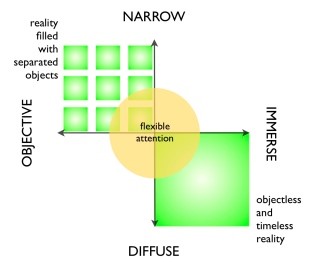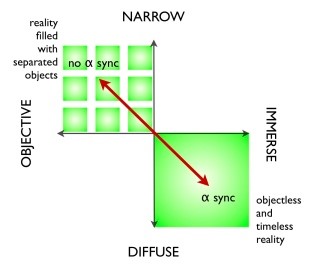By Tomasz Kopec MD
Guest Writer for Wake Up World
I have a good news for seekers of the world. There is a simple theory that can deliver important answers and insights into our reality. If you feel frustrated with your life, exhausted or miserable, if you feel your life is lacking something, then diffusing and balancing your attention with an Open Focus exercise can help you synchronize your brain’s electric code to shape your life in a healthier and happier way.
Open Focus
As you may already know, all stimuli like sounds, light, touch and smell (once registered by receptors inside your ears, eyes, skin and nose) become electric currents travelling along nerves towards your brain. In the brain these currents are processed and your reality is shaped. It means that the whole world around you full of colours, shapes, sounds and smells with its beauty and diversity has to be translated to electric signals in order for you to perceive it.
[pro_ad_display_adzone id=”110028″]
The brain does not see, hear, or smell. It operates using electric currents, full stop. All your knowledge, experience, beliefs, passions, and ideas become part of your reality as small electric charges. Imagine that even you, yourself are – in a way – a group of electric signals travelling across your brain.
It would be quite natural to suppose this electric processing in the brain has to fulfil certain rules and patterns, as you would find in any other system of the body. All imaginable human activities including thinking, feeling, loving, fighting, craving and achieving, should be based on these common rules. There should be a way to understand and use them in science, mathematics, psychology, religion and spirituality. They should be universal for all people regardless of culture, tradition or language. Those rules should also connect many seemingly unrelated aspects of reality because all reality we know is produced in our brains.
Once we define these rules we can get the key to understanding ourselves and the world around us, and this is exactly what the Four Attentions Styles Theory offers. It describes a basic rule of the brain’s electrical processing and links it to the way we sense the reality.
How Does It Work?
For example, you are reading these words now. In order to read, you focus on groups of black shapes arranged in lines. Your eyes are perceiving these shapes and translating them into small electric signals. These signals are being sent right now to an area of your brain towards the back of your head that is responsible for vision. They are processed there, and shared with the rest of your brain. Then, on the basis of your knowledge, experience and beliefs, they are being translated into letters, words and sentences – and they become meaningful to you.
This happens when you are focused on words. However, if you defocus slightly and widen your field of vision, you quickly notice that there is something else on the page in front of you. There is a lot of white space between and inside the letters. I would like you to realise, that the black letters and white space on the page are equally important in forming this page of text. Without white space the page would be completely black and without black letters the page would be only white. In either situation it would not be a page of text any more. Letters and white space are inseparable parts of the same thing – or, in other words they are the same thing.
The same applies if you replace a letter with any other object. For example, the book in your hands seems separated from you by empty space. Yet, if you defocus again (in three dimensions this time) you soon realise that empty space between you and the book and any other solid object around you is an integral part of the reality. As with the page of text, without space there would be only one solid object. Without objects there would be only empty space. Solids objects (including you) and space are inseparable parts of the same thing. In other words – they are the same thing.
Four Attentions Styles Theory
You can see now that one of the basic features of the brain’s electric code is to mark a distinction between objects and space around them. It enables you to read, to walk without bumping into other people, and to sense a difference between you and the rest of the world. According to Dr. Lester Fehmi, the neuroscientist and psychologist behind the four attention styles theory, your brain does it naturally all the time, by generating electric signals that are out of sync (in alpha frequency).
It should be mentioned now that electric signals in the brain oscillate all the time traveling up and down along brain cells. You can compare them to rubber balls bouncing one next to another. They can be in sync (when they bounce together) or out of sync (when they have different speeds or directions).
When electric signals in the brain are out of sync, you are noticing objects (like letters on the page) excluding the ‘silent’ background from your awareness. This way of perception make all objects seemingly separated from one another. It is commonly associated with focusing (narrowing attention) on things. We attend to reality in the narrow and objective way.
On the other hand when signals are in sync you are equally aware of objects and space between them. Everything seems connected and unified. This style of attention is called immersed. It tends to happen when we defocus (diffuse attention) hence this style is described as diffused and immersed.
The four attentions styles theory says that when you are focused on objects, ignoring space between them, you are in the narrow/objective attention style and your brain waves are out of sync.
When you are simultaneously aware of objects and space, you are in the diffused/immersed attention style and your brainwaves are in sync.
See the graph how attention styles can be presented on a graph.
It means that everything is separated and connected at the same time. The reality we live in is simultaneously divided, broken into small pieces and immersed in one. It depends on your attention style – how you see the World and live you life.
When your attention is narrow the reality seems to be filled with separated objects. Everything has its borders in time and space. You focus on one object (problem, issue, idea, person, detail, etc…) after another trying to be precise and striving for perfection. When you let your attention diffuse, all objects (including you) merge with space around them and everything becomes one. It is the easiest way to relax, immerse with the world around you and discover that everything is already connected and gently vibrates in ideal harmony.
Now, a Few Examples…
The wave in the ocean seems to be separated from other waves if you narrow your attention and focus on it. However, if you diffuse (widen, broaden) your attention – you would see that all waves belong to the same bigger object — the ocean and they have not been separated from it even for a moment. If you diffuse your attention a bit more you would see that the ocean could not exist without the space above it. You can say that waves are separated from one another and the ocean is separated from the space above it. And it is clearly true but only if you are in the narrow attention style. When you became diffused it all becomes one.
Every tree in the forest is separated from other trees. However if you diffuse you attention you would see that all trees are connected and they all together form the forest. You can diffuse your attention a bit more and notice space between trees and around the forest. Trees could not exist without space between them. Trees and a space are part of the same thing. You can diffuse even more and become aware of space inside trees and feel oneness.
Everyone is different. We sense these differences the moment we meet a new person. However, if you diffuse your attention you would see that we all belong to the same group of living species built of a matter from the planet Earth. The matter flows through us and we are connected through this flow. If you diffuse even more you would see that space between us (and above us) is an integral part of reality we live in. The Earth (and we as a part of it) and the Universe around it is the same thing. In other words we are the Universe. We are one.
We are free to choose how to attend your reality and it can never be taken away from us.
The fact is that most of us rely on the narrow/objective attention style. Remember, I had to make you realise that there was white space on the page and that there is a lot of space around you. You naturally focus on objects ignoring space between them. Dr. Fehmi says that overusing the narrow/objective attention style makes the brain electrically unstable. It fuels the sympathetic part of our autonomic nervous system responsible for the fight or flight response. It makes us tired, chronically stressed and brings hidden tension to our lives. It also gives us a distorted view of the world in which everything is separated and distant and it sometimes makes us feel lonely, helpless, anxious and depressed.
On the other hand, the diffused/immersed attention style makes the brain more synchronous and stable. It makes us more relaxed and switches our system to the rest and digest mode. Dr. Fehmi argues that practising this style of attention helps to balance our physiology and to develop a new insight into reality. With this practice, health significantly improves, and it becomes more and more evident that everything is already connected, unified and working in harmony. Dr. Fehmi designed a series of exercises that reinforce this style. He based them on his own experience from the attention training he has been carrying out for most of his life. He uses a neurofeedback machine of his own design that is calibrated on a specific brainwave pattern called ‘the whole brain synchrony in alpha frequency’. According to Dr. Fehmi, this brainwave pattern is directly linked to the diffused/immersed style.
Flexible Attention
Dr. Fehmi’s ultimate goal is to teach people how to develop attention flexibility, which means that you can balance all attention styles at the same time. Attention flexibility is a very real experience that everyone can develop and enjoy. It brings a profound change in the way you behave, you feel about the world and live your life. You can focus (narrow your attention) on objects staying diffused and feeling that everything is one at the same time. You see the materialistic side of the world (full of objects you can get) and you feel deeply the essence of spirituality (where everything is one, unified). You are truly balanced, fulfilled and happy. It also gives you a range of new skills such as relieving physical pain, reducing anxiety, solving problems, improving creativity, mastering your performance in whatever you do and many, many more.
 To understand how attention flexibility works, it is important to realise that an object could be anything you can focus on – a letter on this page, a sound, a smell, a problem, a thought in your head, a challenge, a future goal or a feeling coming from your body such as pain, anxiety or hunger. You may be ready to agree with me that in some sense you consider yourself as an object separated from the rest of the world. None of these objects can exist without space around them. They need a ‘silent’ background to become noticeable for you. In the brain, they all are represented by electric signals being out of sync.
To understand how attention flexibility works, it is important to realise that an object could be anything you can focus on – a letter on this page, a sound, a smell, a problem, a thought in your head, a challenge, a future goal or a feeling coming from your body such as pain, anxiety or hunger. You may be ready to agree with me that in some sense you consider yourself as an object separated from the rest of the world. None of these objects can exist without space around them. They need a ‘silent’ background to become noticeable for you. In the brain, they all are represented by electric signals being out of sync.
When you are attention flexible you have the ability to restore synchrony in your brain. You do it by becoming simultaneously and equally aware of an object and space around it. It makes an object merge with its background and dissolve. You can dissolve your physical pain, anxiety and fear. You can solve – or dissolve – problems or make your future challenges achievable with ease and joy. You see your opponent as a target which is distant from you (out of sync) and an integral part of you (in sync) at the same time. You can fight against him and love him at the same time. It stops you from freezing with fear or being overwhelmed with rage. You can remain balanced, having access to all of your resources and win a fight while staying in harmony with the world and your beliefs.
If you feel frustrated with your life, exhausted, miserable and sorry for yourself, if you feel your life is lacking something it is probably lack of balance. Balance of your attention. Try an Open Focus exercise to feel for yourself how diffusing attention feels like. You will love it.
The Open Focus Theory
Video courtesy of Tomasz Kopec on YouTube.
About the author:
 From Tomasz Kopec MD: I enjoy helping people and making the Universe a happier place. Fortunately, I work as a family doctor and this is a part of my job description 🙂 For many years I had some questions at the back of my mind, like: what is happiness, what is love, who we are, where we go after death, where this all suffering is coming from…? I have been a regular meditator since I was a teenager (mostly Zen tradition) and I was searching for answers in my head and in my heart.
From Tomasz Kopec MD: I enjoy helping people and making the Universe a happier place. Fortunately, I work as a family doctor and this is a part of my job description 🙂 For many years I had some questions at the back of my mind, like: what is happiness, what is love, who we are, where we go after death, where this all suffering is coming from…? I have been a regular meditator since I was a teenager (mostly Zen tradition) and I was searching for answers in my head and in my heart.
My turning point was reading a book The Open Focus Brain by Dr. Lester Fehmi. He runs a neurofeedback clinic for attention disorders at Princeton, New Jersey, US. I enrolled an Open Focus workshop and I became a true enthusiast of Dr. Fehmi’s approach. I love it because it beautifully connects the western scientific way of thinking with far east approach to reality. It also gives a very simple, practical solutions to a physical pan, anxiety, insomnia, creativity etc. I would like to make Open Focus a lot more recognizable because it is worth it!
To learn more about Open Focus, visit:
[pro_ad_display_adzone id=”110027″]








